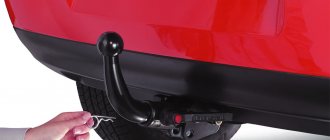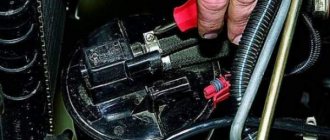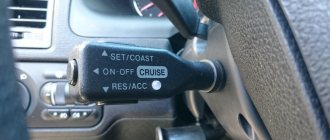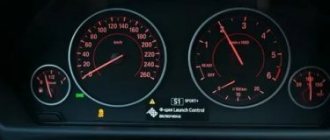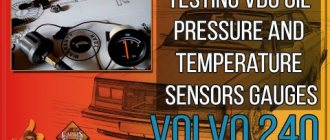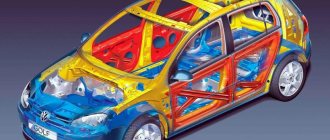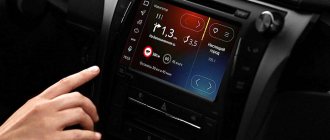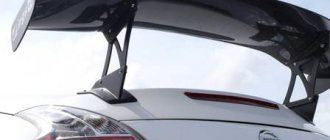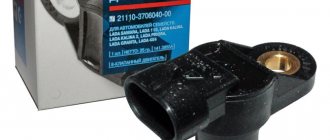Today, many motorists prefer cars with a turbocharged engine, and this is not surprising, since such an engine has incredible power, which is very attractive for fans of high speeds. Everyone knows that When operating even a “low-power” motor, a huge amount of thermal energy is generated. And for the correct operation of the power unit in a car with a powerful engine, a special device is installed - an intercooler. Today we will tell you what it is in a car, why it is needed and how it functions.
What is an intercooler and why is it needed?
During operation of the turbocharging system, the air entering inside is compressed under pressure. As a result, the density of the air mixture changes, and its temperature increases to almost 200 degrees (Celsius). Not only compression contributes to temperature changes, but also heating by the turbocharger itself, which is heated by exhaust gases. The result of a sharp increase in temperature is a decrease in air density. This leads to a decrease in pressure during boost.
The intercooler is used to lower the temperature of the air mixture by 50-60 degrees (Celsius). Due to this, the cylinders will be able to accumulate more air, which will provoke an increase in engine power. Experts say that the engine power indicator will change by 3% per 10 degrees by which the temperature was reduced. A good intercooler can increase power by 20%, but no more. At the same time, the risk of exhaust gas detonation is reduced.
Intercooler operating cycle
Pros and cons of using an additional radiator
Surely, now you understand what an intercooler is and what its main purpose is. But questions remain about the feasibility of its installation. Therefore, it is necessary to mention the pros and cons of using an additional cooling device.
Efficiency of use
How effective is installing an intercooler in a car? Without hesitation, we can say that the efficiency of the cooling device is obvious!
For example, cooling the air masses by only 10ºС increases the performance of the power unit by approximately 3-4%. At the same time, even an air intercooler cools the air flow by approximately 50ºС, and, consequently, the increase in power is 15%. But the record holder is the water system, which ensures a decrease in temperature to 70ºС, and this is 21% of the engine power.
As you can see, installing an additional cooling device is quite justified. But it should be emphasized that they are installed exclusively on turbocharged engines, because ordinary engines do not have similar volumes of air masses pumped into the cylinders and there is no excessive heating.
Cons of an additional radiator
Even the most ideal radiator is not ideal! So the intercooler has some disadvantages. Let's talk about them:
- Reduced pressure. It is clear that air masses passing through a large number of pipes expend part of their own energy to overcome obstacles.
- Weight. Whatever you say, this intercooler has a decent weight - there are examples weighing up to 20 kg.
- Water device, requires additional cooling. In addition, the device itself requires significant attention, since when liquid leaks out, its operating efficiency drops several times.
Types of intercoolers
Types of intercoolers - what is poured into the intercooler?
Air intercooler
. The device, operating according to the air-to-air circuit, has become widespread among car owners due to its simplicity of design. A system of tubes and plates is used to cool the air mixture. Tubes increase the path that air must travel, plates provide optimal heat transfer. The only drawback is the loss of boost pressure, which occurs due to a change in the direction of the tubes, which means the appearance of obstacles in the air path.
Types of intercoolers.
The effectiveness of the air intercooler is evident at speeds of more than 30 km/h. The location for installing the device can be:
- The space under the hood of a car directly above the engine (the air intakes are cut into the hood).
- The space behind the front bumper (air intakes are cut into the bumper).
- Space in the sides of the wings (air intakes are cut into the wings).
The second and third options can be found more often, because they provide greater intensity of blowing of the heat exchanger. An example would be the Subaru Impreza and Mitsubishi Lancer models. In addition, the air type intercooler is popular among owners of trucks and large SUVs.
Liquid intercooler
. Unlike the air type, the liquid counterpart is considered more efficient in operation. It has a complex design that includes:
- Air radiator.
- Control block.
- Pipe system.
- Water pump.
- Other.
The resulting dual-circuit cooling system can use not only water as a liquid, but also a refrigerant (antifreeze, antifreeze or liquid nitrogen). Due to the properties of these liquids, rapid heat transfer and cooling of the air mixture occurs.
The disadvantages of a liquid intercooler are: the time required to cool the coolant and the cost of the device along with additional devices.
Diagram of the part and its location in the engine
Externally, the intercooler resembles a radiator consisting of plates and pipes. In order to additionally cool the air, copper or aluminum plates are welded to the tubes.
Externally, the intercooler is not much different from the radiator
In the engine, the part is mounted between the intake manifold and the turbine compressor. It is mounted in the front part of the engine below the radiator, or above the engine. In some car models, the intercooler is located in the wings.
Advantages and disadvantages of an intercooler
As mentioned earlier, using an intercooler allows you to achieve better engine power. But that is not all. Improved cylinder filling saves fuel by using it more efficiently. The operation of the intercooler reduces the toxicity of exhaust gases, which has a beneficial effect on the environment and will certainly be of interest to everyone who cares about the environment.
The disadvantages of using an intercooler include:
- The need for considerable free space under the hood;
- Expensive maintenance after intercooler damage.
Most often, the device installed in the bow of the car is damaged. It can be disabled by small stones or a minor accident.
And where to look for it?
If you own a car with a turbo engine, finding an intercooler will be quite easy. Most likely, it is installed frontally, in front of the radiator grille. It is installed in front of the cooling radiator and air conditioner, taking on the main air flow. Or the intercooler is placed under the radiator, in which case the cooling system works more efficiently. Sometimes it can be installed above the engine, and the hood receives a special air intake for cooling. Well, for additional dirt intake, accordingly, such an arrangement will require a little more attention to the cleanliness of the engine compartment.
Which intercooler to choose - optimal technical characteristics
An air-to-air intercooler should be selected depending on the engine type and its characteristics. The main design parameters when designing the device are:
- Total area of all tubes and plates. The higher its indicator, the more efficiently the intercooler will cope with its task. For each engine there is an optimal area value. It guarantees excellent efficiency. Larger heat exchangers can provide an increase in efficiency, but it will be insignificant.
- Internal section. The optimal value allows you to avoid loss of air pressure in the intercooler.
- Heat exchanger wall thickness. Don't think that thick walls are better. For efficient operation of the device, average thickness values are suitable.
- Frontal area value. The amount of air that passes through the device depends on this parameter. The more air mixture passes through the pipes, the higher the cooling capacity of the intercooler.
- Intercooler pipe shape. In order to avoid loss of flow, it is necessary to ensure that the transition parts have conical segments, and that maximum radii are always left at the bends of the tubes.
- Tightness of connecting pipes. Lack of tightness will lead to loss of pressure during boost. The material from which the pipes are made must be highly resistant to gasoline, engine oil or high temperatures. High-quality material will protect the pipes from damage and leakage.
- Direction of flow in the heat exchanger. It must create all the conditions for the maximum flow area.
Having studied the design parameters, each car owner will be able to understand what affects the operation and choose the intercooler he needs from the entire range presented.
Compliance with technical requirements allows you to create the ideal device for a specific type of machine.
Is it possible to remove it?
And lastly, is it possible to get rid of this device? Of course you can, why not! However, often such alterations do not lead to anything good. Just think for yourself how much the engine performance will drop, by about 15 - 20%, but do you need “it”? And the air supply system, which is located on the engine, is not designed for such high temperatures, so without an intercooler it may suffer. By the way, you can use it to determine whether your turbine is working; watch a short video.
I will say more, one of the most common types of tuning is the installation of an intercooler of a large size and volume, for the passage of large volumes of air, and, accordingly, for better cooling. Also, many tuners install special air intakes on the hood of the car that direct the incoming cold flow directly to the intercooler housing, which further increases the efficiency.
I will end here, I hope my article was useful to you, bye everyone - sincerely yours, AUTOBLOGGER.
Similar news
- Types of turbines. What kind are on the car, what to choose
- How often should you change the fuel filter? Let's look at a separate variant...
- How to remove the bumper of a Hyundai Solaris. Let's disassemble the front part, photo...
Add a comment Cancel reply
Features of intercooler operation
Modern intercoolers do not require special maintenance. Periodic inspection of the device and knowledge of the main signs of failure of its parts allows you to timely detect the problem and eliminate it without serious consequences.
Most often, a pipe or heat exchanger ruptures. The reason for this is high blood pressure. The problem can be identified by a sharp decrease in engine power and an increase in the amount of fuel consumed by the car.
You can avoid reducing the efficiency of the intercooler by periodically flushing it. Having gotten rid of small debris, you don’t have to worry about clogged honeycombs, which negatively affect the properties of the intercooler.
Please note that when washing, under no circumstances should you resort to using high-pressure apparatus. A strong jet of water directed at the honeycombs can bend their walls and disrupt operation.
Main causes of malfunctions and repair methods
Intercoolers require constant inspection and periodic maintenance. If the operating requirements established by the manufacturer are met, these mechanisms will work for a very long time. Typical malfunctions of these units are listed below.
- Destruction of connecting pipes. Typically, pipes rupture due to excess pressure. In this case, the engine will sharply lose power and fuel consumption will increase. Failed pipes cannot be repaired - only replaced.
- Exceeding the standard amount of oil inside the intercooler. If the oil consumption in the device exceeds 1 liter per 10,000 km , then it should be immediately sent for major repairs.
- Defects in cooling surfaces. Cracks and dents on the cooling plates are not acceptable. Methods for repairing such defects depend on their size.
- The inner diameter of the tubes decreases. Most often this is the result of blockage. It is necessary to regularly clean and restore the flow area of the tubes.
How to increase intercooler efficiency?
Sprinkling the intercooler with water
Owners of sports cars resort to irrigating the heat exchanger with water. This measure allows you to increase the efficiency of the air intercooler. An example of a car model where a special sprayer is regularly used is the Subaru Impreza WRX STI and all its modifications. In order to provide the additional device with the required amount of water, a 12-liter tank is installed in the trunk. An additional electric motor allows you to quickly transfer water to the sprayer after pressing a button on the dashboard.
Liquid type models do not require modifications. The only thing that can be done to improve the performance of the intercooler is to choose a coolant that will cope with the task more efficiently and cool down faster.
Disadvantages of the device
The intercooler is not a perfect system. It has a number of disadvantages such as:
- Decreased pressure. A flow that passes through many elements gives up some of its energy to overcome them.
- Heavy weight. The device can weigh up to 20 kilograms.
- Availability of additional coolant for water systems.
- Constant attention should be paid to the water intercooler system, since liquid can leak out at any time and the efficiency of the entire system will quickly decrease.
Cost of intercoolers of various types
The range of intercoolers is quite large. For domestic cars (for example, VAZs), you can choose inexpensive front intercooler options. The cost of an air-type device will range from 3,500 to 5,400 rubles. The exact price may depend on the size of the heat exchanger, the diameter of the inlet pipe, the quality of the material and design, as well as the manufacturer. An average liquid intercooler will cost between 5000-7000 rubles.
Owners of foreign cars will have to spend a lot of money to buy a good intercooler. Its price is much higher than for domestic cars. It is difficult to give an exact value, because a certain type of device is suitable for each model. But for example, let’s say that installing an intercooler on an Audi A3 will cost about 50,000 rubles.
But this is not the price limit. The most expensive intercooler models are those for sports cars. For example, an HKS Intercooler designed for a Subaru Impreza GRB will cost about 120 thousand rubles, for a Toyota Supra car model - 118 thousand rubles, and for such a famous car as the Nissan GT-R R35 - from 250 thousand rubles or more.
It is worth noting that among all types there are also universal intercoolers. They can fit several car models, regardless of engine characteristics. The price of such devices exceeds 4 thousand rubles.
Kinds
There are several types of intercoolers: “air/air” and “air/water”. There are also special types of intercoolers that can cool the incoming air to a temperature below ambient temperature. Such high efficiency is achieved through the use of ice or nitros (nitrous oxide).
- Air/air intercoolers The air/air intercooler type is reliable and has a fairly simple design, which includes a pipe and a plate radiator. As the name implies, such an intercooler uses air for cooling, so its efficiency, which directly depends on the size of the device, is not particularly high.
The operating principle of an air/air intercooler is that air flows through the tubular fins of the radiator. Thin pipes usually have small baffles inside them that create turbulence and increase heat transfer.Typically, intercoolers are made from aluminum. The air that enters when the car moves forward is responsible for lowering the temperature inside the radiator, carrying excess heat into the atmosphere.
- Water/air intercoolers These types of intercoolers are used less frequently than air/air intercoolers, but due to their several advantages, they are often used in cases where there is not enough space under the hood to install an air/air intercooler.
Water/air intercoolers involve the use of a special heat exchanger located under the hood near the compressor. Water or a special liquid receives heat, which goes out through a small radiator located at the front. The water/air intercooler consists of a control unit, radiator, heat exchanger, pump and pipes.The advantage of a water-air intercooler is that water conducts heat more intensely than air. In order for the temperature rise to be absorbed, there must be enough water in the heat exchanger. Even before the pump supplying cold water starts working, the heat exchanger reduces the temperature of the air that enters the collector. This system works quite efficiently, but if the water gets hot, it will take time to cool down.
Why is the intercooler in oil?
Intercooler in oil
Oil in the intercooler is the first sign of a dangerous problem. It is possible to determine how serious it is only by visual inspection of the parts. This is also facilitated by knowledge of the main reasons for oil getting into the intercooler:
- Malfunction of the oil line
located between the engine crankcase and the turbine. The drain pipe must not be pinched or damaged. The result of damage to the oil line can be high pressure in the system, which will lead to the appearance of microcracks in the intermediate cooling radiator. They can only be eliminated by welding. - Deformation of the oil pipe material
. The deformation can be eliminated by aligning the position of the pipe or replacing the seals. If there is an excessive amount of oil, only replacing the assembly part will help. - Failure of the air vent
due to mechanical damage (formation of holes). To fix the problem, the part needs to be replaced. - Oil filter malfunction
. Replacing the filter and cleaning the air vent will solve the problem. - Crankcase ventilation failure
. The problem occurs when the oil level in the engine crankcase exceeds. It is unlikely to be solved by local repairs or partial replacement of parts. Most likely, you will have to do a major overhaul of the engine with the replacement of many parts (rings, pistons, seals, drain pipe, etc.).
A small amount of oil in the intercooler of a turbocharged engine is quite normal, but if there is a lot of it there, then you should worry about the performance of the turbine.
If there is a sharp drop in power, in addition to the turbine, the intercooler must also be checked, since even the slightest leak of air under pressure helps to significantly reduce it.
DIY intercooler repair
Repair of a part begins with its dismantling. It is not practical to describe specific removal steps, since everything depends on the location and method of installing the part in the car. For example, if a part is installed above the motor, it is simply “pulled off” by loosening the clamps. When the intercooler is installed as one unit with radiators (main, automatic transmission, air conditioning), you will have to make some effort.
It is important! The intercooler can only be removed from a completely cooled engine with the ignition system turned off.
For a complete repair, it is necessary to dismantle the part.
After removing the part, take the following steps:
- Cleaning. This procedure can last about 2-3 hours. Oil stains are especially difficult to get rid of. But it is necessary to remove all contaminants: the performance of the intercooler in the future will depend on the quality of the work performed. For cleaning, remove all parts and disconnect the pipes. The outer surface and channels are thoroughly washed with special auto chemicals, and for better removal of oil, they are soaked for several hours. Do not use gasoline or other oil solvents: they can damage the material from which the part is made.
- Sealing cracks. The cracked element is removed from the part body, the damaged area is cleaned with a file and a platinum patch is soldered onto it. The material of the insert must match the material of the removed tube.
- Pressure testing in a water bath or testing with a smoke generator. Before installing the repaired part in place, it is a good idea to check the quality of the repair. This will save the motorist from the need for repeated removal in case of poor quality work. The real test of the part is driving at a reasonable speed. If the engine operates with its former power, and no extraneous whistles are heard during gas changes, it means that the performance of the part has been restored.
It is important! The most serious failure is a violation of the ventilation crankcase, which occurs due to the excess oil level in the part. Local repairs in this case will not solve the problem. The engine will need to be overhauled and the intercooler replaced.
Any car owner can handle minor repairs and maintenance of the intercooler. In the event of a serious breakdown or if it is necessary to replace the model with a more advanced one, you should contact a specialist auto repair shop.
- Author: Andrey
Rate this article:
- 5
- 4
- 3
- 2
- 1
(14 votes, average: 3.9 out of 5)
Share with your friends!
Home →
Maintenance and Repair →
Which brands can you trust?
If you are not a professional racer, you can buy an intercooler from a large concern. Professionals usually place personal orders, which are worked on by the best specialists. Products from the following manufacturers are suitable for city driving: Valeo (France), Behr and Hella (Germany), Nissen (Denmark).
The following ones will cost less: Thermotec (Poland), Klokkerholm and JP Group (Denmark).
Relatively inexpensive options are offered by the following manufacturers: NRF (Netherlands), Ava Quality Cooling (Germany), Magneti Marelli (Italy). They will not allow you to “squeeze out” 100% power, but the vast majority of car owners are not racers.
How to cool the air?
What kind of beast this intercooler is, we have found out in general terms. Now let's look at practical ways to lower the temperature of a hot air mass. In fact, the engineers did not come up with anything particularly abstruse when deciding what the cooler should be like, and made it in the form of a large radiator. There are several varieties of this device:
- air cooling;
- water cooling.
The first type, as its name suggests, uses incoming air flow to cool the air coming from the compressor. It is the most common due to the simplicity of the design, but, however, it has specific requirements.
For example, the intercooler radiator in this case should have only straight air ducts, which, in turn, have to be made very long for the cooling process to be effective. Because of this, the dimensions of the device are quite impressive.
Water intercoolers are less demanding on free space. In this case, the air is cooled by water circulating through the radiator. Although such structures are quite compact and extremely efficient, they are more complex to manufacture and maintain, because you still need to ensure the water cycle, which means additional pumps, pipes and other parts. As a result, we get a high price.
Intercooler heat exchanger internal volume
When choosing an intercooler based on the calculated overall dimensions, you must also remember about its internal volume. A heat exchanger that is too small will create high air resistance, which will cause a significant drop in boost pressure. Excessive volume increases accelerator pedal response time. Based on the duration of the turbo lag, you can approximately estimate the ceiling of the heat exchanger tank: tL=2kV/Gv, where
- tL—turbo pit duration time (sec);
- Vi — intercooler volume (in3);
- Gv - volumetric air flow (cf/min) in the mode 2000-2200 o6/min;
- k is the reduction coefficient, taking into account the ratio of sec/min and in2/ft2.
The extent to which the importance of the delay in the car's response to the throttle prevails over the level of maximum engine output, or vice versa, depends on the tasks set when building the car. You just need to remember that a turbo hole longer than a third of a second will become a serious obstacle at the start of races and when driving in dense city traffic.
Methods of application
The efficiency of such cooling equipment becomes noticeable at speeds that exceed 30 km/h. In addition to the possibility of increasing productivity, incorrect placement can disrupt the operation of the intercooler, which will lead to unpleasant consequences.
It may also be interesting: The clutch pedal has fallen in and won’t return, what’s the problem?
Most often, the intercooler is placed close to the radiator. Specifically, in front of him, in the bumper area. This gives a good opportunity to connect with the cooling from the radiator. This way the system will need less clutter to function fully (fewer pipes). Obviously, since the radiator itself runs on water, then an intercooler with a water operating system will be more efficient in its efficiency, and will also save more space. By the way, when tuning the Passat B3, you can also install an intercooler in it.
We recommend: Gasoline or diesel. What's better?
But even the air-to-air system is still more efficient to place in this position. Additional cooling above the engine, as well as from the side of any wing, also looks acceptable. But in general, the location of the heat exchanger should be convenient and easy to install, so it is best to place it in the front, as mentioned above.
Intercooler intake tract diameter size
With an increase in the speed of inflatable air in the inlet and outlet pipes of the intake system, the resistance to its movement also increases, and resonant processes develop. With excessively large diameters, the inertia of the turbo system increases dramatically. as they add volume to the overall system. There is a certain speed optimum, equal to approximately 0.25-0.28 of the speed of sound, or 450 ft/sec, at which negative phenomena do not exceed a critical level. Based on these values, the appropriate intake tract diameter can now be calculated.
- s=π(d/2)2=ηA/VB, where
- VB - flow velocity in the intake tract (275-308 ft/sec);
- Po - air flow passing through the motor at maximum power mode cf/min);
- s is the cross-sectional area of the exhaust pipeline (in2);
- d - pipeline diameter (in)
- η — reduction coefficient equal to 2.4 (min/sec)/(ft2/in2).
How not to make a mistake in choosing
The best solution would be to look for an intercooler using your vehicle's VIN code if turbocharging is a standard option. In the same way, it can be found using the technical data of the car, without making a mistake.
It is much more difficult to take a part for tuning. Unfortunately, it is difficult to do without the help of a specialist. He will take into account the thickness of the metal, shape, characteristics of the car, and examine the engine compartment. Again, you can make the choice yourself, but there is no guarantee of significantly increasing engine power. Remember the following:
- The size must match the size of the turbine;
- Don't go for appearances;
- Find out how well the air is supplied to the intercooler;
- Don't choose a part with a thick core;
- Make sure that pipes of one diameter smoothly transition to pipes of another diameter;
- The intercooler pipes must be durable, the best material is silicone;
- Place the device so that it is well cooled (cooling behind the radiator, in the engine compartment are poor placement options if you have not taken care of insulation and proper placement of pipes).
Also remember: bar-and-plate and tube-and-fin layouts perform equally well in mid-range vehicles (up to 350 hp).
SQUARE
The difference in the heat exchange area of intercoolers may be a consequence of design nuances. For example, it is reduced by reducing the number of channels and increasing their cross-sections while maintaining the volume of the heat exchanger. This design will result in lower resistance, resulting in lower pressure drop, but reduced cooling efficiency. It is preferable to include such designs in low-pressure systems.
Conversely, the higher the expected boost pressure, the more dense the structure with a high heat exchange area should be selected. If a decrease in the heat exchange area occurs due to a decrease in the volume of the intercooler (less length or number of channels), then this is primarily reflected in the pressure drop due to both an increase in flow rate and a deterioration in cooling. But the turbo lag becomes less noticeable.
Popular faults
Reviews from owners of turbocharged cars, where an intercooler is used, clearly show that the water and air type of device can fail equally often.
Sometimes the culprit may be a worn-out and loose clamp. In other situations, the fastening is normal, but rupture still occurs. Replacing a device is not always a logical solution, since repairs are quite possible. Moscow is also ready to offer a wide list of auto repair shops that are ready to fix the leak and restore the intercooler without completely replacing it. Some manage to do this with their own hands by looking at photos and video materials.
I would highlight 3 main malfunctions of intercoolers:
- Break. That is, cracks appear on the body, which is often caused by mechanical damage. Due to the increase in pressure, ruptures are quite likely. Here you can try to solder the system. If this does not help, you will have to change it;
- Pipe branch. If it is in oil, then you have found the problem. Traces of oily liquid at the junction of the pipe fixation are a direct confirmation of the malfunction. Here you should use an O-ring. If it does not hold up, then simply change the pipe;
- Pollution. To prevent malfunctions, it is recommended to periodically clean the intercooler. Cleaning is divided into internal and external. External means regular pressure washing using soft brushes and machine detergents. For the internal one, you will have to dismantle the intercooler.
And here the question arises of how to remove the device. After all, without dismantling, independent replacement will be impossible. Even if I wanted to, I cannot give any universal instructions. Each car has its own mount and location of the intercooler. Therefore, the easiest way here is to look at the official operating manual for your machine.
It’s difficult to say how much repairs at a car repair shop will cost. But it’s hardly worth counting on an amount less than 1000-1500 rubles.
As you can see, the intercooler is a really useful and extremely important device in the operation of turbocharged engines. If the cooler fails, the turbine will quickly end. Thank you all for your attention! Share your opinion in the comments, ask questions and look forward to many new materials on our website!
